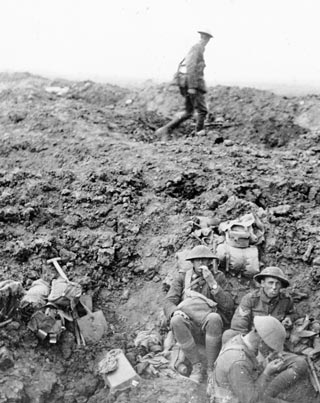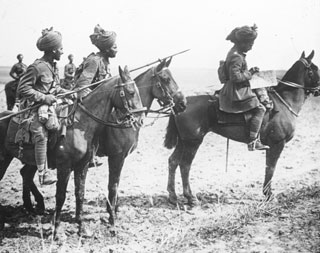Troops in a shell hole (MB367/148959)
Troops of 2nd Canterbury Battalion, New Zealand Division, resting in a shell hole during the Battle of Flers-Courcelette. (Royal Engineers No. 1 Printing Co.; Flers, Somme, France; 15 September, 1916).

Retracing the origin of the collection, stretching throughout the British Empire, and its historical significance.
This section written by Greg Hynes
The collection of First World War photographs in the Macmillan Brown Library’s archives came to the library as part of a collection donated by the Canterbury Branch of the Victoria League of New Zealand. However, little else was known about the collection. Through research conducted over the summer of 2011 and 2012, the provenance and history of the collection can now be more fully traced.
The photographs are a collection of lantern-slides, a technology used to give lectures and slide-shows. The slides resulted from the reorganisation of British propaganda during 1916-17, and an increased focus on photographic propaganda. In 1916 Ernest Brooks, the first official British photographer, was posted to the Western Front. Therefore, the Battle of the Somme, which many of the slides depict, was the first battle to be extensively officially photographed by the British.
In early 1917, Wellington House, the propaganda branch responsible for visual propaganda, produced a large number of slides to be distributed throughout the empire. The tone of the slides was imperial, promoting the strength, unity, and diversity of the British Empire, especially amongst white settler dominions such as New Zealand.

The Victoria League’s was connected to British propaganda through figures such as John Buchan, head of Department of Information, and his wife, who were also members of Victoria League committees. Distribution of British propaganda through groups such as the Victoria League was common, as the Victoria League had the networks, stretching throughout the empire, and to Canterbury, that Wellington House needed to exploit. Such distribution allowed a level of secrecy for British propaganda. The Victoria League also shared British propagandists’ focus on imperial unity, and methods such as hosting lectures, creating and distributing pamphlets, and visiting primary schools.
From the London headquarters, collections of slides were sent to all branches of the Victoria League throughout the empire, and to branches of the Canadian-based Imperial Order of the Daughters of Empire. The lack of direction from the Victoria League in London as to the use of the slides, and autonomy of the league’s branches in New Zealand, led to a range of varying uses of the slides. Collections in Auckland and Wanganui were used in public lectures to raise funds and present the empire’s war effort. The Otago branch used its collection to promote the imperial cause in primary schools. It was also decided at the annual national conference of the Victoria League in Christchurch in 1918, that the slides would be used to recruit new members.
One of the persisting mysteries of this project, however, is the use of the Canterbury branch’s slides. Due to the absence of other First World War Victoria League material from the Macmillan Brown collection, and any other mention of the use of the slides in the Christchurch Press, it was not possible to gain a definitive account of the slides’ uses in Christchurch. Perhaps the slides were used in private. Perhaps they arrived too late, or perhaps the slides did not conform to the war work the Canterbury branch had already established, or perhaps they were too busy.
Regardless of the truth, the slides themselves are important. They show the methods and aims of British propaganda, and the wide variation of war work conducted by the Victoria League in London and New Zealand. Furthermore, the slides remain as physical evidence of the imperial connections between New Zealand, Britain, and the rest of the empire, which were utilised, and at times strengthened, during the First World War. Therefore, the slides remain part of Canterbury’s imperial legacy.
View the entire collection online

By clicking "Accept All Cookies", you agree to the storing of cookies on your device to enhance site navigation, analyse site usage, and assist in our marketing efforts.
0800 827 748 (within NZ)
+64 3 369 3999
Ext: 92111 (from a campus landline)
Direct dial: 0800 823 637
University of Canterbury | A Fair Trade University